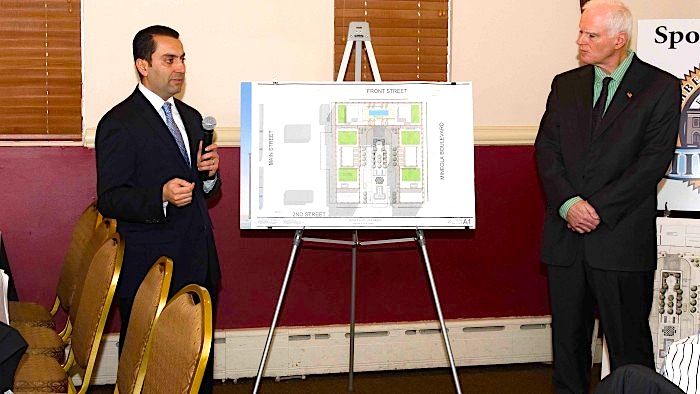An independent traffic analysis on the proposed nine-story building on Second Street in Mineola found that the development plan includes sufficient parking and that the moderate increase in traffic could be accommodated with minor road changes.
The recently published analysis, conducted by RMS Engineering and paid for by the village, backs up the findings of a previous, developer-funded study by VHB Engineering, Surveying and Landscape Architecture, P.C.
“It is our opinion that the methodology utilized (by VHB)…accurately predicts the future operation of the existing roadway network upon the completion of the project,” the RMS analysis says. “We believe that the proposed action will not have a significant impact on traffic activity in the area.”
The proposal under review, also known as the Village Green, would permit a nine-story, 266-apartment building with retail and restaurant space on the ground floor. The proposal has been the subject of a series of contentious hearings before the Mineola Board of Trustees.
The building would be located at the site of the Second Street Citi Bank, bordered by Mineola Boulevard to the West and Station Plaza North to the South. The proposal includes a 478-space parking lot beneath the building with the entrance and exit on Station Plaza North.
Like the VHB report, the RMS analysis concluded the proposed building’s proximity to the train station would likely limit traffic and parking demand during peak hours, though not by as much as in urban areas.
Mineola trustees Paul Pereira and George Durham declined to comment on the analysis until it is officially presented at a public hearing, the next of which is scheduled for March 11.
“Interpreting the report at this time before it is presented and before the engineer has an opportunity to answer questions from the board and the public might be characterized as speculation,” Pereira, who is also deputy mayor, said in an e-mail. “That is something I don’t want to engage in at this point.”
At past hearings, some residents questioned the legitimacy of a traffic study paid for by the New Hyde Park-based-developer, Lalezarian Properties LLC. But still others said a study’s conclusion could not compete with empirical observation.
“One of the gentleman who spoke before me suggested that we do an impromptu traffic study of our own – I do that every day,” said Sebastian Alia, who lives on First Street, at the Feb. 11 hearing. “If you go up to the intersection of Mineola Boulevard and First Street, there’s virtual gridlock. That’s not going to get better by increasing development.”
Alia also questioned whether a study could accurately forecast traffic pattern changes prior to the completion of two other large buildings under construction near the train station, including a 315-unit building also developed by Lalezarian at 250 Old Country Road.
“We have two residential units going up on Old Country Road, and they’re still unoccupied and still untested in regard to their impact on the local community, on the downtown, and on traffic patterns,” he said. “I don’t know what the rush is…but let’s slow this down.”
The RMS analysis seconded two traffic mitigation measures called for in the previous study: allowing two-way traffic on Station Plaza North east of the parking garage exit and adding a dedicated right-turn lane to the westbound approach to Mineola Boulevard and Second Street.
Combined, the changes would eliminate eight on-street parking spaces, six at Station Plaza North and two at the Mineola Boulevard Second Street intersection. The analysis says eliminating the spaces should not have a major impact on parking.
“It is the opinion of RMS engineering that the required mitigation associated with this action will be minor in nature and will assure the continued operation of the roadway network at acceptable levels of service,” the analysis says. “Because the reduction in the availability of on-street parking is minimal, it is the opinion of RMS Engineering that undertaking this action will not result in undue hazard or congestion in the area.”
The analysis goes on to say that the 488 parking spaces included in the proposal – 478 in the parking garage and 10 valet parking stalls — would be sufficient because parking demand would be staggered between the residential and commercial uses.
Parking demand for residential units would be highest at the late evening hours, while for retail and restaurants it would be highest during midday and early evening, respectively, the report says.
“Due to the fact that the uses contemplated at the subject property do not experience the maximum parking demand at the same time, and because the transit-oriented development reduces the need… to have a personal vehicle,” the analysis says, “we are in agreement with the VHB TIS regarding the adequacy of the parking provided for the proposed facility.”
To complete its report, the RMS analysis reviewed a number of intersections within a half-mile radius of the proposed building’s location, somewhat expanding the scope of the previous study. It used case studies and industry metrics to forecast the increase in traffic, which the analysis says represents only a fraction of current traffic.



